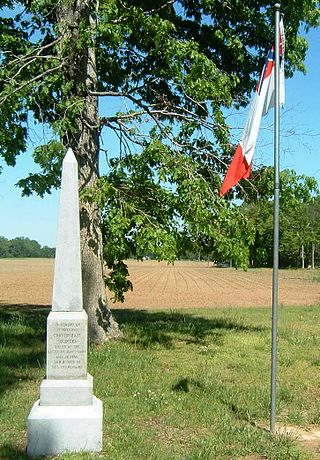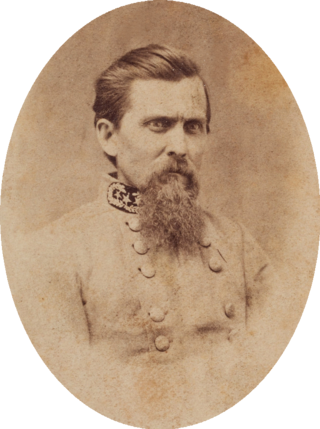
Matthew Duncan Ector was an American legislator, a Texas jurist, and a general in the Confederate States Army during the American Civil War.
The Third Battle of Murfreesboro, also known as Wilkinson Pike or the Cedars, was fought December 5–7, 1864, in Rutherford County, Tennessee, as part of the Franklin-Nashville Campaign of the American Civil War.

The Battle of Haw's Shop or Enon Church was fought on May 28, 1864, in Hanover County, Virginia, as part of Union Lt. Gen. Ulysses S. Grant's Overland Campaign against Confederate Gen. Robert E. Lee's Army of Northern Virginia during the American Civil War.
The Battle of Fort Bisland was fought in the American Civil War between Union Major General Nathaniel P. Banks against Confederate Major General Richard Taylor during Banks' operations against the Bayou Teche region in southern Louisiana.
The Army of Western Louisiana was a part of the Confederate States Army during the American Civil War. It fought in all the major engagements during Union Maj. Gen. Nathaniel P. Banks' campaign to capture Port Hudson, Louisiana. For much of its existence, it served under Maj. Gen. Richard Taylor. Perhaps its crowning achievement was its victory in April 1864 at the Battle of Mansfield.

The Battle of Baton Rouge was a ground and naval battle in the American Civil War fought in East Baton Rouge Parish, Louisiana, on August 5, 1862. The Union victory halted Confederate attempts to recapture the capital city of Louisiana.

The Texas Brigade was an infantry formation of the Confederate Army that distinguished itself in the American Civil War. Along with the Stonewall Brigade, they were considered the Confederate Army's shock troops. It fought in every major battle of the Eastern Theater except Chancellorsville.

Major-General John George Walker was a Confederate general in the American Civil War. He served as a brigadier general under Stonewall Jackson and James Longstreet, before commanding the Texas Division unit in the Trans-Mississippi Department, known as Walker's Greyhounds for their speed and agility. He was ordered to disrupt U.S. Grant's supply-line opposite Vicksburg, Mississippi, but Grant had managed to cross to the East Bank, and Walker was reduced to minor operations, one of them against some of the first African-American troops to serve in battle. He was able to make a bigger contribution to the Red River Campaign in support of General Richard Taylor.
1st Arkansas Mounted Rifles (1861–1865) was a Confederate States Army cavalry regiment during the American Civil War. The unit was formed as a mounted infantry regiment, but was dismounted in the spring of 1862 and remained dismounted for the remainder of the war. The unit participated in the earliest battles in the western theater at Wilson's Creek and surrendered with the remnants of the Army of Tennessee in North Carolina in April 1865.
The 30th Arkansas Infantry (1862–1865) was a Confederate Army infantry regiment during the American Civil War. This regiment was also called the 5th Arkansas Cavalry, the 5th Trans-Mississippi Regiment or 39th Regiment after April, 1863. This regiment was converted to mounted infantry for Price's Missouri Expedition in 1864 and was known as Rogan's Arkansas Cavalry. There were two regiments officially designated as the 30th Arkansas Infantry. The other 30th Arkansas served east of the Mississippi River and was redesignated as the 25th Arkansas Infantry.
The 39th Arkansas Infantry Regiment or the 6th Trans-Mississippi Rifle Regiment was an infantry formation of the Confederate States Army in the Trans-Mississippi Theater of the American Civil War, and was successively commanded by Colonels Albert W. Johnson, Alexander T. Hawthorn, John B. Cocke, and Lieutenant-Colonel Cadwallader Polk.

The 12th Texas Cavalry Regiment was a unit of mounted volunteers recruited in Texas that fought in the Confederate States Army during the American Civil War. The regiment was enrolled in state service in September 1861 and in Confederate service the following month. The regiment fought at Whitney's Lane, Cotton Plant, and L'Anguille Ferry in 1862, Goodrich's Landing in 1863, and Blair's Landing and Yellow Bayou in 1864. The unit also participated in numerous skirmishes and scouts. It disbanded in May 1865.

The 16th Texas Cavalry Regiment was a unit of mounted volunteers from Texas that fought in the Confederate States Army during the American Civil War. The regiment was recruited in early 1862 and mustered into Confederate service in April 1862. The unit fought as cavalry at the Battle of Cotton Plant but it was dismounted in the summer of 1862. The 16th Cavalry served as infantry in Walker's Texas Division for the remainder of the war. The regiment fought at Milliken's Bend, Mansfield, Pleasant Hill, and Jenkins' Ferry. The unit marched to Texas in early 1865 and disbanded in May 1865.

The 27th Texas Cavalry Regiment, at times also known as Whitfield's Legion or 1st Texas Legion or 4th Texas Cavalry Battalion, was a unit of mounted volunteers that fought in the Confederate States Army during the American Civil War. First organized as the 4th Texas Cavalry Battalion or Whitfield's Legion, the unit served dismounted at Pea Ridge and First Corinth. Additional companies from Texas were added and the unit was upgraded to the 27th Texas Cavalry Regiment or 1st Texas Legion later in 1862. Still dismounted, the unit fought at Iuka and Second Corinth. The regiment was remounted and fought at Holly Springs in 1862, Thompson's Station in 1863, and at Yazoo City, Atlanta, Franklin, and Third Murfreesboro in 1864. The regiment surrendered to Federal forces in May 1865 and its remaining soldiers were paroled.

The 24th and 25th Consolidated Texas Cavalry Regiment was a unit that originally consisted of two regiments of mounted volunteers that served in the Confederate States Army during the American Civil War. However, by the time the two regiments were consolidated, they fought as infantry. Both regiments organized as cavalry near Hempstead, Texas in April 1862 and were dismounted to fight as infantry in July 1862. The two regiments served in the same brigade and were captured at the Battle of Arkansas Post in January 1863. After being sent to Northern prison camps, the soldiers were exchanged in April 1863. Assigned to the Army of Tennessee, the two regiments were consolidated with two additional Texas cavalry regiments and in 1863 fought as infantry at Liberty Gap, Chickamauga, Missionary Ridge, and Ringgold Gap. In 1864, the other two Texas regiments were detached and the consolidated 24th and 25th fought as a separate infantry unit in the Atlanta campaign, at Franklin, and at Nashville. For the Carolinas campaign, the 24th and 25th fought at Bentonville before being reconsolidated with other Texas regiments and surrendering in April 1865.

The 13th Texas Cavalry Regiment was a unit of mounted volunteers recruited in Texas that fought in the Confederate States Army during the American Civil War. The regiment was enrolled in Confederate service in February 1862 and served exclusively west of the Mississippi River. The unit was later dismounted and became part of the Texas infantry division known as Walker's Greyhounds. The regiment fought at Milliken's Bend in 1863 and Mansfield, Pleasant Hill, and Jenkins' Ferry in 1864. The regiment disbanded in May 1865, but its official surrender date was 2 June 1865.

The 18th Texas Infantry Regiment was a unit of volunteers recruited in Texas that fought in the Confederate States Army during the American Civil War. The regiment was enrolled in Confederate service in May 1862 and always campaigned west of the Mississippi River in the region known as the Trans-Mississippi Department. The unit was assigned to the Texas infantry division known as Walker's Greyhounds. The regiment fought at Milliken's Bend, Richmond (La.), and Bayou Bourbeux in 1863 and Mansfield, Pleasant Hill, and Jenkins' Ferry in 1864. The regiment disbanded in mid-May 1865, but its formal surrender date was 26 May 1865.

The 11th Texas Infantry Regiment was a unit of volunteers recruited in Texas that fought in the Confederate States Army during the American Civil War. The regiment organized in the winter of 1861–1862 and always served west of the Mississippi River in the Trans-Mississippi Department. The unit was assigned to the 2nd Brigade of the Texas infantry division known as Walker's Greyhounds. The regiment fought at Milliken's Bend and Bayou Bourbeux in 1863 and Mansfield, Pleasant Hill, and Jenkins' Ferry in 1864. The regiment disbanded in mid-May 1865, but its formal surrender date was 26 May 1865.

1st Texas Field Battery or Edgar's Company was an artillery battery from Texas that served in the Confederate States Army during the American Civil War. The artillery company formed in November 1860, but was not formally taken into Confederate service until April 1861. The unit participated in the disarming and surrender of United States soldiers and property in Texas in early 1861. The battery marched to Arkansas where in 1862 it joined the infantry division known as Walker's Greyhounds. The battery fought at Milliken's Bend and Richmond (La.), shelled a Federal river transport, and campaigned in south Louisiana in late 1863. The 1st Texas Battery was captured at Henderson's Hill in March 1864. The soldiers were later exchanged, and the unit disbanded in 1865 at the end of the conflict.

The 28th Texas Cavalry Regiment was a unit of mounted volunteers recruited in east Texas that fought in the Confederate States Army during the American Civil War. In May 1862, the regiment entered Confederate service and served the entire war west of the Mississippi River in the region known as the Trans-Mississippi Department. The unit was soon dismounted before being assigned to the 2nd Brigade of the all-Texas infantry division known as Walker's Greyhounds. In 1863, the regiment played a secondary role at Milliken's Bend. The regiment fought in three major battles during April 1864, at Mansfield, Pleasant Hill, and Jenkins' Ferry. The Trans-Mississippi Department surrendered on 26 May 1865, but the survivors dispersed to their homes before that date.















